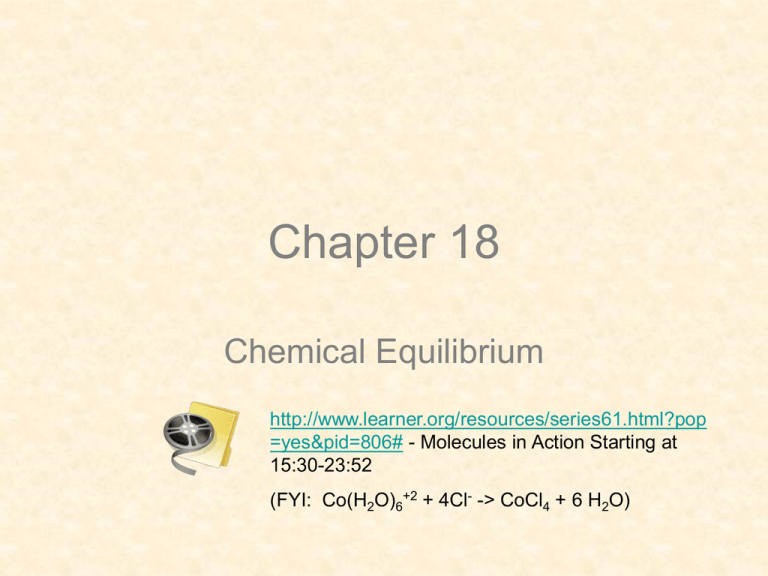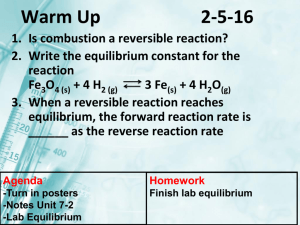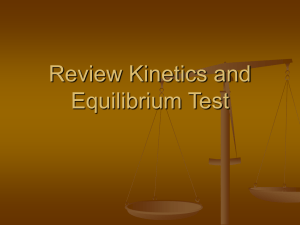Chapter 18
advertisement

Chapter 18
Chemical Equilibrium
http://www.learner.org/resources/series61.html?pop
=yes&pid=806# - Molecules in Action Starting at
15:30-23:52
(FYI: Co(H2O)6+2 + 4Cl- -> CoCl4 + 6 H2O)
Reversible Reactions
• Reversible Reaction
– Reaction that can proceed in either direction
–↔
• Chemical Equilibrium
– Rate of forward rxn = rate of reverse direction
• The Equilibrium Constant (K)
– Compares concentrations of products to
reactants at equilibrium
Reversible Reactions
• For the reaction:
aA + bB cC + dD
K = [C]c[D]d
[A]a[B]b
Interpretation K = [products]coefficients
[reactants]coefficients
Reversible Reactions
• Example:
H2 + I2 ↔ 2HI
Given data:
Experiment
[H2]
[I2]
[HI]
1
0.0004953
0.0004953
0.003655
2
0.001141
0.001141
0.008410
3
0.003560
0.001250
0.01559
4
0.002252
0.002336
0.01685
Calculations of K:
K
Reversible Reactions
• Example:
– A mixture of N2, O2, & NO at equilibrium has [N2] =
6.4x10-3M, [O2] = 1.7x10-3M, and [NO] = 1.1x10-5M.
Find K for the reaction:
N2(g) + O2(g) ↔ 2NO(g)
Reversible Reactions
• FYI – SOLIDS AND LIQUIDS HAVE
CONCENTRATIONS SO LARGE THEY
ARE ESSENTIALLY NOT GOING TO
CHANGE (a intensive property), SO YOU
CAN almost always IGNORE THEM IN
THE K EXPRESSION!!
Shifting Equilibrium
• Remember LeChatlier????
• Changes in pressure
– Affects systems with GASES involved
– Move mixture to a smaller container…
• Creates increased pressure
• Rxn will shift to side with FEWER mole of gas to
help alleviate that pressure
• Example
– N2 (g) + 3H2 (g) ↔ 2NH3 (g)
– In a smaller container – will shift RIGHT, K stays the
same!!
Shifting Equilibrium
• Changes in concentration
– Add more of a substance, shifts to use it up
(shifts away from an added substance), K
stays the same
• Changes in temperature
– A reversible rxn is ENDO in one direction and
EXO in the other
– An increase in temp causes a shift so the
ENDO rxn occurs more
– K does change!!
Shifting Equilibrium
• Common-ion effect
– Adding a substance with an ion which is also
in the rxn shifts equilibrium
– Example
• CH3COOH + H2O ↔ H3O+ + CH3COO-1
• Adding NaCH3COO gives CH3COO-1, so causes a
shift LEFT
Calculations involving shifts in
equilibrium
• Reaction Quotient
– Same form as K, but can be used at any point in a
rxn, NOT just at equilibrium
– Q = [C]c[D]d
[A]a[B]b
• If Q = K, then
– The system is at equilibrium
• If Q > K, then
– Need more reactants (less product), so shift LEFT
• If Q < K, then
– Need more product, so shift RIGHT
Calculations involving shifts in
equilibrium
• Example:
K for the rxn N2 (g) + 3H2 (g) ↔ 2NH3 (g) is 2.37x10-3. At a
given point in the rxn, the concentrations are: [N2] = 0.683M, [H2] =
8.80M & [NH3] = 3.65M. Calculate the value of Q and determine the
direction of the rxn.
Equilibria of Acids, Bases, and
Salts
• For weak acids: An acid losing its
hydrogen ion has an equilibrium constant,
Ka
• Example:
CH3COOH + H2O ↔ H3O+ + CH3COO-1
Ka = [H3O+][CH3COO-1]
[CH3COOH]
** H2O is not in expression, because it is a liquid so it
has a concentration which essentially does not change **
Equilibria of Acids, Bases, and
Salts
• Buffers
– Has both the acid and its conjugate base in
the solution (or base and it conjugate acid).
– Example
• CH3COOH & CH3COO-1
• NH3 & NH4+1
Equilibria of Acids, Bases, and
Salts
• Hydrolysis (adding water)
– Anion hydrolysis
• Weak acid anions (F-1, CH3COO-1) can react with
H2O to remove a proton
• F-1 + H2O ↔ HF + OH-1
– A BASIC SOLUTION IS FORMED
– Cation hydrolysis
• Weak base cations (NH4+1) can react with H2O to
add a proton
• NH4+1 + H2O ↔ H3O+1 + NH3
– AN ACIDIC SOLUTION IS FORMED
Solubility Equilibrium
• Solubility Product = Ksp
• Used for slightly soluble or insoluble
substance dissolving
• Example
– AgCl (s) ↔ Ag+1 (aq) + Cl-1 (aq)
{AgCl is insoluble, but
still a LITTLE will dissolve!!}
– K = [Ag+1][Cl-1]
• AgCl not included because it is a solid. So
concentration does NOT change.
Precipitation Calculations
• KBaSO4 = 1.1x10-10. If [Ba+2] = 5.0x10-3M &
[SO4-2] = 2.5x10-3M, will a precipitate
form?
BaSO4 (s) ↔ Ba+2 (aq) + SO4-2 (aq)





